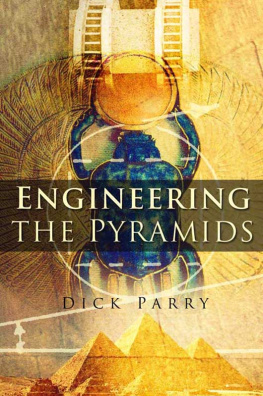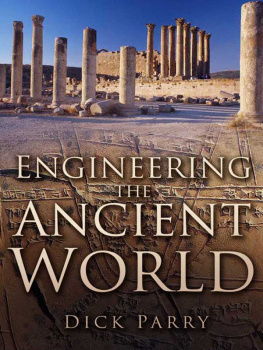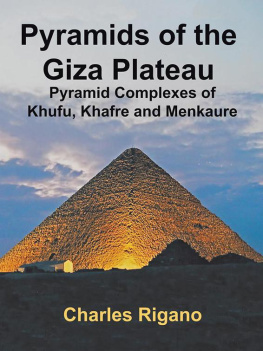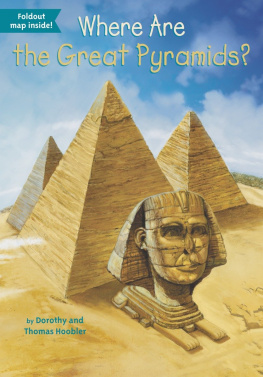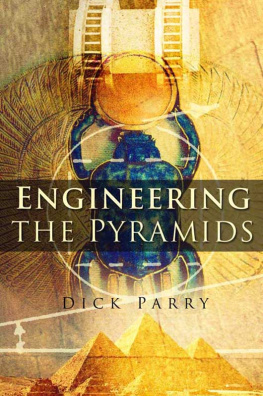Parry - Engineering the pyramids
Here you can read online Parry - Engineering the pyramids full text of the book (entire story) in english for free. Download pdf and epub, get meaning, cover and reviews about this ebook. City: Stroud, Egypt, year: 2013, publisher: The History Press, genre: Non-fiction. Description of the work, (preface) as well as reviews are available. Best literature library LitArk.com created for fans of good reading and offers a wide selection of genres:
Romance novel
Science fiction
Adventure
Detective
Science
History
Home and family
Prose
Art
Politics
Computer
Non-fiction
Religion
Business
Children
Humor
Choose a favorite category and find really read worthwhile books. Enjoy immersion in the world of imagination, feel the emotions of the characters or learn something new for yourself, make an fascinating discovery.
- Book:Engineering the pyramids
- Author:
- Publisher:The History Press
- Genre:
- Year:2013
- City:Stroud, Egypt
- Rating:5 / 5
- Favourites:Add to favourites
- Your mark:
- 100
- 1
- 2
- 3
- 4
- 5
Engineering the pyramids: summary, description and annotation
We offer to read an annotation, description, summary or preface (depends on what the author of the book "Engineering the pyramids" wrote himself). If you haven't found the necessary information about the book — write in the comments, we will try to find it.
Engineering the pyramids — read online for free the complete book (whole text) full work
Below is the text of the book, divided by pages. System saving the place of the last page read, allows you to conveniently read the book "Engineering the pyramids" online for free, without having to search again every time where you left off. Put a bookmark, and you can go to the page where you finished reading at any time.
Font size:
Interval:
Bookmark:
First published in 2004 by Sutton Publishing
The History Press
The Mill, Brimscombe Port
Stroud, Gloucestershire, GL5 2QG
www.thehistorypress.co.uk
This ebook edition first published in 2013
All rights reserved
Dick Parry, 2004, 2013
The right of The Author, to be identified as the Author of this work has been asserted in accordance with the Copyrights, Designs and Patents Act 1988.
This ebook is copyright material and must not be copied, reproduced, transferred, distributed, leased, licensed or publicly performed or used in any way except as specifically permitted in writing by the publishers, as allowed under the terms and conditions under which it was purchased or as strictly permitted by applicable copyright law. Any unauthorised distribution or use of this text may be a direct infringement of the authors and publishers rights, and those responsible may be liable in law accordingly.
EPUB ISBN 978 0 7524 9513 2
Original typesetting by The History Press
T he three stone pyramids on the Giza plateau, visible from central Cairo, are probably the most recognisable man-made creations on earth and the most photographed. To stand beside them, even as a civil engineer, is to be awestruck at their immense size and to feel disbelief that 4,500 years ago people like ourselves could have built such structures without the technology and machines we have today. No wonder ridiculous theories such as alien builders from outer space have found gullible adherents.
For whatever reason, the ancient builders left behind no indication of the construction methods for any of the seven completed stone pyramids, in written or pictorial form, or in the physical shape of tools dating from the pyramid age. This hasnt prevented writers on the subject from disregarding the limitations posed by simple principles of engineering mechanics and making categorical statements about their construction; for instance that sleds were used to transport and raise the stone blocks, without presenting any supporting evidence and while glossing over the enormous problems attending their usage. It almost seems that something which appears in print often enough must be true, or certainly worth repeating. Of course, sleds may have been used, but they would have posed great difficulties in the creation of suitable haul roads and a practical ramp system. Any method to reduce friction, the bane of sled haulage, may have been simple in the hauling of a single sled, but could have been a nightmare with a hundred sleds or more in transit from quarry to site at any given time. Proposed ramps for raising the stones are sketched with absurd inclines of 1 in 2 or steeper, which could not have been negotiated by any method of stone haulage; and ramps are shown climbing up to 100m or more in height, having side slopes almost vertical, with no mention of what miracle material was used in their construction. The reason is simple. If sensible inclines and side slopes had been introduced into the sketches for the particular ramp configurations proposed, the ramps would have swamped the pyramids themselves. As the methods of pyramid construction were not recorded, they must have been transmitted by word of mouth and by practical demonstration, perhaps eventually coming to be known only to the priesthood, which makes the accounts of pyramid construction by Herodotus of particular interest.
The questions posed by the pyramids are endless. Were the bodies of the pharaohs really interred in them or were they an over-the-top diversionary tactic? What motivated Imhotep to extend his original mastaba for his king, to end up with the Step Pyramid? What happened at Meidum to cause its collapse and why is the Bent Pyramid bent? Why was the North Dahshur Pyramid built with much flatter slopes than the other stone pyramids? Were the shafts extending from the tomb chambers of the Great Pyramid really to facilitate the passage of Khufus soul to its celestial abode and, if so, why did his son Khafre not build in the same provision for his own soul? Why did Menkaure build such a small pyramid in the shadow of the much larger structures of his father and grandfather? Why are no two pyramids alike, at least in detail? Fortunately, many of these questions are unlikely ever to be answered and as long as these marvellous enigmatic structures keep at least some of their secrets, our fascination for them will not cease.
Unless otherwise stated, all images have been provided by the author.
My sincere thanks go to Tom Kimura for his efforts in arranging the field tests in Japan and, of course, to the Obayashi Corporation for financing and carrying out the tests. It was a great pleasure to work with such an enlightened organisation. I am greatly indebted to Mamdouh Hamza for his unstinting help to me in making my visits to Egypt both pleasant and fruitful, and also for his suggestion that I write this book. My sincere thanks, too, to Moustafa El-Ghamrawy for the many kindnesses he has shown me on my visits to Egypt. On one of my visits to Meidum and Dahshur, I was accompanied by fellow geotechnical engineer Max Ervin, whose observations have proved very helpful, and a comfort to me. Many thanks to him and also to Christopher Feeney, Jane Entrican and Clare Jackson at Sutton Publishing for making the book a reality, and to Sarah Flight for this paperback edition.
T hroughout the more than three millennia of pharaonic rule, those Egyptians of high status who could afford it concerned themselves to an obsessive degree with their welfare in the afterlife. Leading and wealthy citizens took elaborate precautions to ensure their continued existence after death, which they believed depended upon the preservation of their earthly body. Their tombs, often constructed of stone or excavated deep into solid rock, were much more elaborate than their homes and palaces, which, for the most part, consisted of sun-dried mudbrick.
An early form of tomb was the mastaba, the name deriving from the Egyptian for a bench which it resembled in outward appearance. It consisted of a burial chamber below ground level, which housed the body, surmounted by a squat superstructure of sun-baked mudbrick containing cells intended for storage of wine jars, food-vessels, hunting implements and other necessities for enjoying the afterlife to the full. A significant development in the IV Dynasty saw stone replace brick, the interior of the superstructure often consisting of a low-grade local limestone, with an outer facing of fine quality Tura limestone.
The unification around 3100 BC of the two greatly differing geographic regions of Egypt the elongated narrow Nile valley of the Upper, or southern, largely arid region and the fan-shaped Lower, or northern, productive marshy region gave rise to a remarkable civilisation lasting over 3,000 years under pharaonic rule. Although the two regions continued to be administered separately, the wearing by the pharaoh of both the separate white and red crowns of Upper and Lower Egypt symbolised their unification, which remained substantially intact throughout the pharaonic period in part attributable to the wisdom of Menes, the first pharaoh, in establishing the capital at Memphis, some 24km south of modern Cairo, and near the junction of the two regions.
Menes put in hand major construction works to fortify the city, which helped serve his own glorification and, perhaps even more important, also required a workforce of several thousand people from various parts of the country, which may well have helped cement the concept of unification. According to the Greek historian Herodotus, writing around 450 BC and quoting information given to him by priests in Egypt, Menes had Memphis built on land reclaimed from the Nile by diversion of the river from a point some 100 furlongs (20km) south of the city. A dam or embankment gave protection against flooding from the river and the city was enclosed within a white wall of limestone. These efforts were the forerunners of the great construction works to come, to include pyramids and other tombs, temples and canals.
Font size:
Interval:
Bookmark:
Similar books «Engineering the pyramids»
Look at similar books to Engineering the pyramids. We have selected literature similar in name and meaning in the hope of providing readers with more options to find new, interesting, not yet read works.
Discussion, reviews of the book Engineering the pyramids and just readers' own opinions. Leave your comments, write what you think about the work, its meaning or the main characters. Specify what exactly you liked and what you didn't like, and why you think so.

